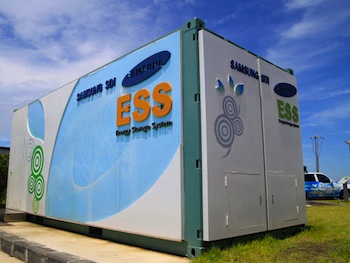 |
| Reviews and Templates for Expression We |
Energy Storage: Important New Industry
Large-scale technology cost-effectively supplies utilities with available energy regardless of fluctuating demand with minimal waste and small-scale technology can keep the lights on during storms and power interruptions, for example. Energy storage also facilitates integration of variable sources of renewable energy - solar and wind - into the grid.
During the first half of 2013, 38 projects have either been announced or deployed - about 633 projects are operating or under development worldwide, says Navigant Research.
Examples of energy storage projects/ policies are:
- Germany's feed-in tariff for energy storage integrated with solar
-
California's requirement of energy storage as a preferred energy source
-
China's battery bank that can store 36 megawatt-hours of power from a nearby 140 MW wind and solar plant. Duke Energy has invested in a similar-sized installation for a wind farm in Texas.
-
Japan's 60 MW battery bank, slated to be operational by 2015.
Samsung's 6 MW battery in the UK:

New technologies, including capacitor battery technology, lithium titanate oxide, nickel-iron, and solar thermal, are swelling the pipeline of advanced energy storage projects. At the same time, new variants on older technologies, such as power-to-gas, are also coming online, reports Navigant.
"There are now 29 different energy storage technologies in use worldwide, some with just a small fraction of the overall market," says Anissa Dehamna, senior research analyst with Navigant Research. "In terms of regional capacity, Asia Pacific continues to be the world leader in deployed capacity, with almost 1.2 gigawatts (GW) representing 47% of global capacity, followed by North America and Western Europe. In terms of installed projects, however, North America leads with 115 deployments."
While Asian economies are moving toward advanced battery technologies, with the intention of developing export industries, European economies are focusing on integrating renewables at both the bulk and distributed level. The North American market is characterized by a policy of funding innovation and, consequently, remains the most technologically diverse region in the industry.
The market for energy storage is extremely fragmented, with at least 136 vendors offering various solutions. Excluding traditional pumped storage, the top three vendors are NGK Insulators, Energy Storage and Power LLC, and Solar Millennium. Energy storage is one of the prime areas for venture capital right now.
Another key development in the energy storage market is the increasing specialization and repositioning of firms in the supply chain. Some technology vendors have repositioned themselves as systems integrators, and in some cases, integrators are entering the sector from other industries. This is a critical time for the advanced energy storage industry - in order for the industry to mature and scale up, more systems integrators are needed, says Navigant.
Navigant's report, "Energy Storage Tracker 3Q13" includes a database of all the projects in the world.
Since energy storage businesses can't find people with the necessary skills, San Jose State University is starting Battery University this summer.
Support from Department of Energy (DOE), FERC
DOE's ARPA-E program has $120 million for its Batteries and Energy Storage Hub, launched last year, to "develop radically new scientific approaches." The goal is to develop technology that provides five times the energy storage achievable today at 20% of the price by 2017.
The Federal Energy Regulatory Commission (FERC) is facilitating use of energy storage through pricing of technologies and ensuring fair market access.
Also, legislation has been introduced that would give a 30% tax investment tax credit to businesses that install storage technology.
|
|
|
|
Copyright 2011 Energy and Technical Services Ltd. All Rights Reserved. Energyts.com |